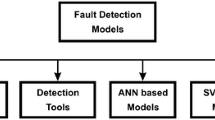Abstract
An artificial neural network (ANN) based on the real coded genetic algorithm (RCGA) has been used with the support vector machine (SVM) for developing the defect diagnostics of the turbo-shaft engine of an aircraft. Nonlinearity increases due to the ascending number of input data in the off-design region. If the ANN algorithm is used by itself to determine defects under this condition, the possibility of falling in the local minima becomes high because of the large amount of learning data. To solve this problem, the expanded multi-class SVM has been used to reduce nonlinearity of input data. The RCGA, which is effective to search the global minima, has been applied to the ANN algorithm to obtain the magnitude of defects. As results, the number of learning data has been decreased and convergence and accuracy have been improved.
Similar content being viewed by others
References
Lt. E. Suits, D. H. Plemmons, G. R. Beitel and R. S. Hiers III, Gas turbine engine flow-field diagnostics: Needs, capabilities, and proposed development, 25th AIAA Aerodynamic Measurement Technology and Ground Testing Conference (2006).
Al. J. Volponi, T. Brotherton and R. Luppold, Development of an information fusion system for engine diagnostics and health management, AIAA 1st Intelligent Systems Technical Conference (2004).
D. H. Seo, T. S. Roh and D. W. Choi, Defect diagnostics of gas turbine engine using hybrid SVM-ANN with module system in off-design condition, Journal of Mechanical Science and Technology, 23(3) (2008) 677–685.
T. Kobayashi and D. L. Simon, A hybrid neural networkgenetic algorithm technique for aircraft engine performance diagnostics, NASA/TM-2001-211088 (2001).
GSP 10 User Manual Version 10.0.07, National Aerospace Laboratory NLR (2004).
PW206C estimated engine performance program user’s manual REV.3 for EEPP 3020 series with EEPP supplement EEPP 3020-04.2 for AGUSTA, Pratt & Whitney Canada Inc. (1995).
N. Cristianini and J. Shawe-Taylor, An introduction to support vector machines, Cambridge University Press (2000).
R. J. Schalkoff, Artificial neural networks, The Mcgraw-Hill Companies, INC (1997).
J. H. Holland, Adaptation in natural and artificial systems, The university of Michigan Press, Michigan (1975).
D. E. Goldberg, Real-coded genetic algorithm, Virtual Alphabets, and Blocking, Complex Systems, 5 (1991).
D. T. Pham and G. Jin, Genetic algorithm using gradient-like reproduction operator, Electronic Letters, 31(18) (1995) 1558–1559.
T. C. Fogarty, Varying the probability of mutation in the genetic algorithm, Proc. 3rd int. Conf. on Genetic Algorithms and Their Applications, Arlington, VA (1989) 104–109.
W. J. Kim and T. S. Roh, A study on defect diagnosis of gas turbine engine using SVM and RCGA-based ANN in off-design region, 20th ISABE Conference, ISABE-2011-1809 (2011).
T. Srikanth and Dr. V. Kamala, A real coded genetic algorithm for optimization of cutting parameters in turning, IJCSNS International Journal of Computer Science and Network Security, 8(6) (2008) 189–193.
S. M. Lee, T. S. Roh and D. W. Choi, Defect diagnostics of SUAV gas turbine engine using hybrid SVM-artificial neural network method Journal of Mechanical Science and Technology, 23(2) (2009) 559–568.
Author information
Authors and Affiliations
Corresponding author
Additional information
Recommended by Associate Editor Tong Seop Kim.
Tae-Seong Roh received his B.S. and M.S. degrees in Aeronautical Engineering from Seoul National University, Korea, in 1984 and 1986. He then went on to receive his Ph.D degree from Pennsylvania State University in 1995. Dr. Roh is currently a Professor at the department of Aerospace Engineering at Inha University in Incheon, Korea. His research interests are in the area of combustion instabilities, rocket and jet propulsions, interior ballistics, and gasturbine engine defect diagnostics.
Dong-Whan Choi received his B.S. degree in Aeronautical Engineering from Seoul National University, Korea, in 1974. He then went on to receive his M.S. and Ph.D degrees from University of Washington in 1978 and 1983. Dr. Choi had served three years as a President of Korea Aerospace Research Institute since 1999. He is currently a professor at the department of Aero-space Engineering at Inha University in Incheon, Korea. His research interests are in the area of turbulence, jet propulsions, and gasturbine defect diagnostics.
Rights and permissions
About this article
Cite this article
Kim, Y., Jang, J., Kim, W. et al. Multiple defect diagnostics of gas turbine engine using SVM and RCGA-based ANN algorithms. J Mech Sci Technol 26, 1623–1632 (2012). https://doi.org/10.1007/s12206-012-0333-7
Received:
Revised:
Accepted:
Published:
Issue Date:
DOI: https://doi.org/10.1007/s12206-012-0333-7




